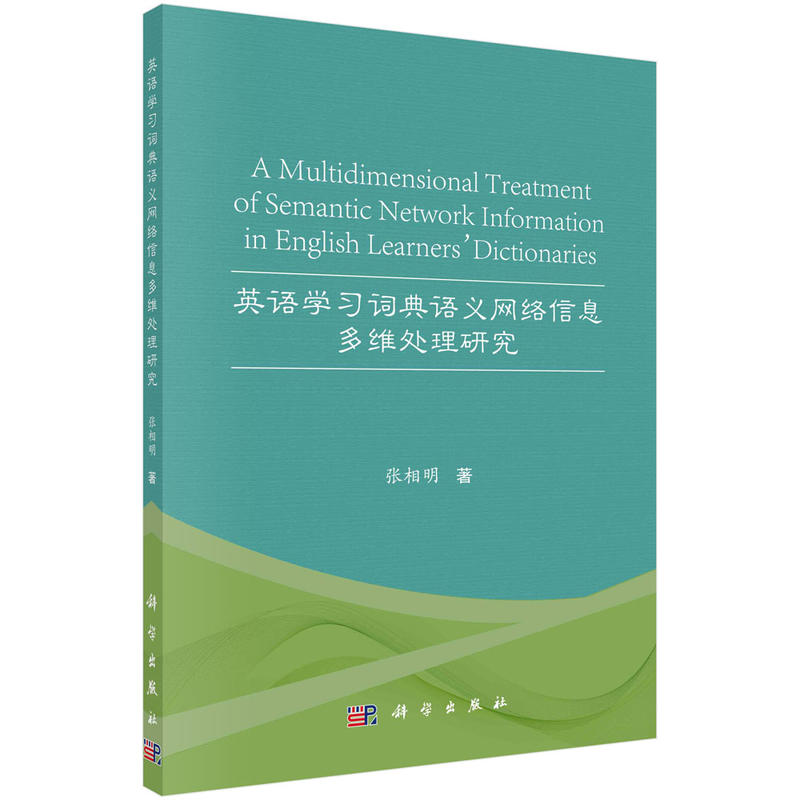- ISBN:9787030576279
- 装帧:一般胶版纸
- 册数:暂无
- 重量:暂无
- 开本:B5
- 页数:244
- 出版时间:2017-06-01
- 条形码:9787030576279 ; 978-7-03-057627-9
本书特色
本书以词汇语义学为理论框架,以英语学习词典的语义网络信息处理为研究对象,从编者、用户、专门词典和呈现方式等四个视角对比剖析了当前英语学习词典语义网络信息处理现状,并以此为基础构建了多维语义网络处理模式(MSNTM),再进一步分析了该模式在二语词汇习得、词典使用、词典编纂等方面的应用和启示。研究发现,国内英语学习词典在语义网络信息呈现方面存在信息量偏少和方式单一等不足;MSNTM涵盖语义关系、词典结构、呈现方式等要素,有助于英语学习词典全面、有效地呈现语义网络信息。
内容简介
本书以词汇语义学为研究视角,以英语学习词典的语义网络信息处理为研究对象,从编者、用户、语义词典和呈现方式等四个不同视角剖析了当前英语学习词典语义网络信息处理现状,并在基础上构建了"多维语义网络处理模式"(MSNTM),再进一步分析了该模式在二语词汇习得、英语学习词典使用、英语学习词典编纂等方面的启示和应用。本研究发现:靠前英汉学习词典在语义网络信息呈现方面存在信息量偏少和方式单一等不足;多维语义网络处理模式涵盖语义关系、词典结构、呈现方式等要素,可以帮助英语学习词典中全面、有效地呈现词目的语义网络信息。
目录
作者简介
张相明,江西信丰人,博士,副教授,2004年获广东外语外贸大学语言学硕士学位,2016年获华南师范大学教育学博士学位,2004年至今在广东财经大学任教,兼任中国辞书学会双语词典专业委员会理事、辞书理论与辞书史专业委员会委员等。主要研究方向为双语词典学和应用语言学;发表学术论文30余篇,合著《中国辞典史论》等学术著作3部,参编《当代英语介词词典》等英语词典3部;主持完成教育部人文社科研究青年基金项目和广州市哲学社科规划一般项目等,研究成果曾获广东省哲学社科优秀成果奖三等奖(排名第三)等;获国家公派访问学者资格,赴美国德克萨斯大学奥斯汀分校深造。
-

地心游记(纯英文)/床头灯英语.3000词读物
¥5.4¥15.8 -

茶花女
¥4.2¥12.0 -

流浪地球刘慈欣
¥21.1¥62.0 -

小妇人(纯英文)/床头灯英语.3000词读物
¥4.7¥15.8 -

了不起的盖茨比(纯英文)/床头灯英语.3000词读物
¥4.5¥12.8 -

本杰明:富兰克林自传
¥4.7¥13.5 -

THE GREAT GATSBY-了不起的盖茨比
¥6.9¥16.8 -

Sons and Lovers
¥7.8¥26.0 -

方法论
¥3.9¥9.5 -

写给儿童看的英语:情境联想600句(英汉对照)
¥17.1¥39.8 -

最新英汉百科图解词典-升级版
¥104.2¥168.0 -

命案目睹记
¥21.7¥33.8 -

沉思录
¥10.5¥21.0 -

巴黎圣母院
¥4.7¥15.5 -

英诗选译-孙大雨译文集-(英汉对照)
¥12.2¥36.0 -

莎士比亚四大悲剧(世界文学名著英文版)
¥12.2¥32.0 -

城堡
¥13.0¥26.0 -

查拉图斯特拉加是说
¥14.5¥29.0 -

飞鸟集(泰戈尔英汉双语诗集)
¥9.5¥11.9 -

无英语词根与单词的说文解字(新版)(2020)
¥52.7¥65.9













